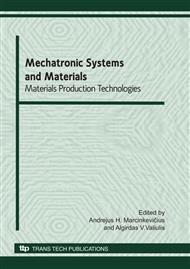p.316
p.321
p.330
p.336
p.342
p.348
p.353
p.359
p.365
Application of Syntactic Pattern Recognition Approach in Design and Optimisation of Group Machining Systems
Abstract:
The focus of this paper is on planning applications of group technology (GT) and the design of related layouts for multi-assortment cellular manufacturing (CM) of mechanical parts. A methodical approach is developed to optimally solve cell formation (CF) problems with CM systems design, which consists in the identification of machine cells and corresponding part families. The approach involves the use of syntactic pattern recognition concepts from the field of artificial intelligence (AI). It is based on methods of strings matching and clustering, applied extensively in genetics, molecular chemistry and biological sciences. The CF strategy followed implies clustering character strings that denote machine sequences in process routings. Numerical quantification of dissimilarity between part routings by a specific distance measure and the concept of average linkage clustering algorithm (ALCA) are at the core of the clustering procedure. The use of the approach is studied numerically with regard to a real industrial case and diverse layouts of cellular system are considered, including those with machine sharing. Group process alternatives with given system layouts and workflows prototyped by definite job sequencing rules, are simulated using programmed models. Generated design solutions are subjected to further analysis and quantitative evaluation by assumed measures of their operational performance.
Info:
Periodical:
Pages:
342-347
Citation:
Online since:
June 2010
Authors:
Price:
Сopyright:
© 2010 Trans Tech Publications Ltd. All Rights Reserved
Share:
Citation:


